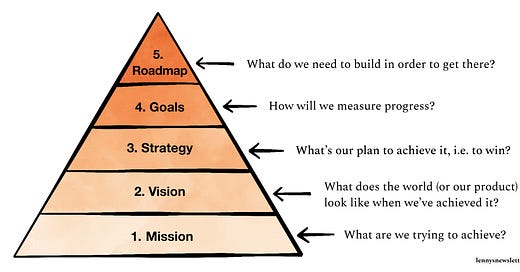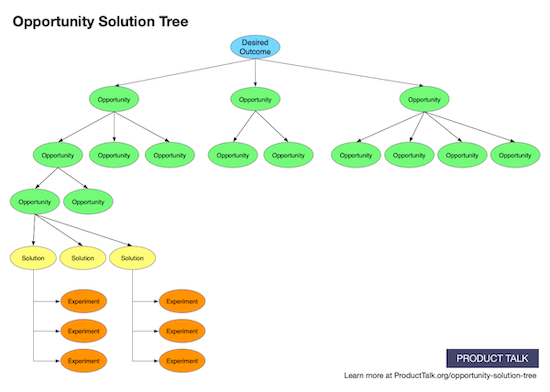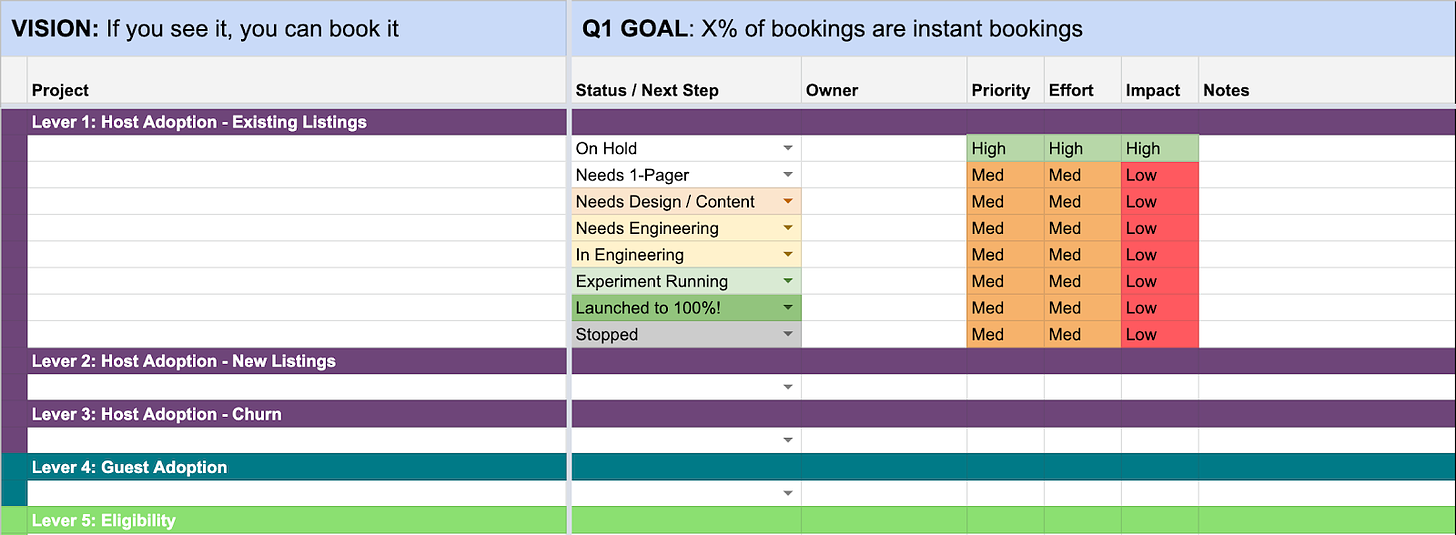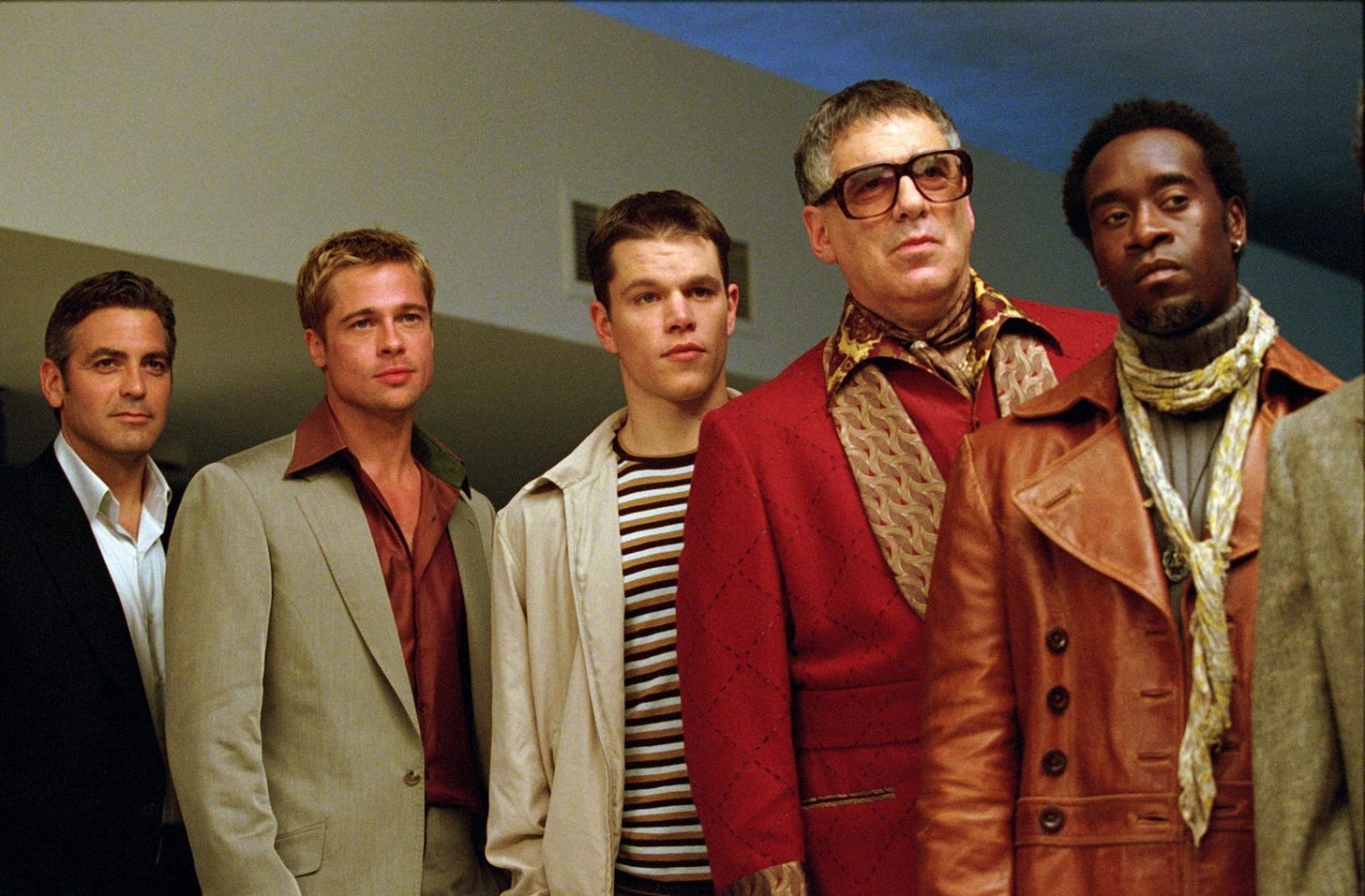👋 Hey, I’m Lenny and welcome to a 🔒 subscriber-only edition 🔒 of my weekly newsletter. Each week I tackle reader questions about product, growth, career, and anything else that’s stressing you out about your work.
Q: How do strategy, vision, mission, goals, and roadmap all work together? Where should I start?
First, some definitions:
Mission: What are we trying to achieve?
Vision: What does the world look like when we’ve achieved it?
Strategy: What’s our plan for achieving it, i.e. what’s our plan to win?
Goals: How will we measure progress?
Roadmap: What do we need to build in order to get there?
Task: What’s one unit of work we can tackle next?
Where should you start?
Normally you start with your mission—why does your team (or company) even exist? What are you trying to achieve? What is your purpose?
Some examples of great missions:
Tesla: “Accelerate the world’s transition to sustainable energy.”
TED: “Spread ideas.”
Stripe: “Increase the GDP of the internet.”
IKEA: “Create a better everyday life for the many people.”
Patagonia: “Use business to inspire and implement solutions to the environmental crisis.”
Slack: “Make work life simpler, more pleasant, and more productive.”
Google: “Organize the world’s information and make it universally accessible and useful.”
World Wildlife Fund: “Conserve nature and reduce the most pressing threats to the diversity of life on Earth.”
Nike: “Do everything possible to expand human potential.”
Square: “Make commerce easy.”
Vision
Next comes your vision: What does the world (or your product) look like when you’ve achieved your mission?
Some examples of great vision statements:
Microsoft: “A computer on every desk and in every home.”
Alzheimer’s Association: “A world without Alzheimer’s disease.”
Teach for America: “One day, all children in this nation will have the opportunity to attain an excellent education.”
Tesla: “Create the most compelling car company of the 21st century.”
Lyft: “A world where cities feel small again. Where transportation and tech bring people together, instead of apart.”
Netflix: “Become the best global entertainment distribution service.”
If you start with your vision before your mission, that’s totally OK. Elon Musk likely started with a vision of the world he wanted to see and then developed his mission around that. No problem. Don’t overthink it.
Strategy
Once you have your mission and vision, this is where strategy comes in. Your strategy is simply your plan to achieve your vision—your plan to win.
I’ve written about getting better at strategy, and, to boil it down, a strategy is essentially a short description of your plan, with 3 to 5 concrete investments that, if you get right, will bring you closer to winning (i.e. achieving your vision). Here are some templates to help you frame your thinking.
Here are some high-level examples of strategies:
Tesla: Build a high-priced sports car → Use that revenue to build an affordable car → Use that revenue to build an even more affordable car → While doing so, also provide zero-emission electric power
Uber: Launch Uber Black → Bring prices down by launching UberX → Bring prices down by launching Uber Pool → Bring prices down by launching scooters, bikes, etc.
Substack: Build powerful publishing tools for writers → Help writers become better writers through value-add services → Grow their audience through network effects
Additional examples of great real-life strategies:
GitLab: Notice the clear mission, vision, and three-part strategy.
Salesforce: Simple, but tells you exactly what needs to be done.
Yahoo’s “peanut butter” memo: Notice how clearly this identifies the problem, and includes a three-part strategy. (Also, it’s obviously memorable since it’s now known as the “Peanut Butter Manifesto.”)
Tesla: Notice the narrative style, the detailed identification of the problems, and the very simple, ambitious yet clear four-step strategy at the end.
Teresa Torres’s opportunity solution tree framework is a great way to think through, and communicate, your strategy:
Goals
Next, you can begin to define your goal. Goals are simply a way to measure the progress of your strategy toward achieving your ultimate vision.
Some examples of visions and their associated goals:
Microsoft: A computer on every desk and in every home → X% of homes with a computer
Teach for America: One day, all children in this nation will have the opportunity to attain an excellent education → X% of children with education
Alzheimer’s Association: A world without Alzheimer’s disease → X% decrease in Alzheimer’s cases
Here’s my advice on setting goals and on choosing your North Star metric.
Roadmap
And finally, once you have your goals, you can align around and prioritize a roadmap. Here’s a template you can use.
Within the roadmap, you break out individual tasks, the atomic unit of work for your teammates.
Why do you need goals before you align around a roadmap and prioritize tasks? Because when prioritizing the many ideas your team has, you look at the ROI—the effort vs. the impact. The impact you’re prioritizing against is based on how much you expect the project will impact your goals.
That’s basically your plan as a product team, from the 10,000-foot mission to the day-to-day work of your team.
As an example, here’s how it all fits together in the case of Tesla:
And finally, let’s look at another “real-life” example:











